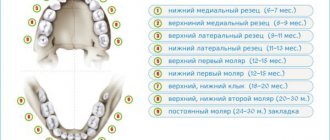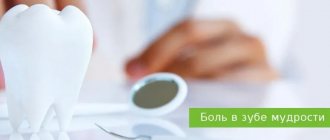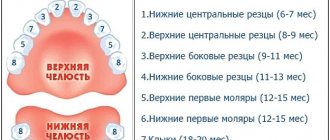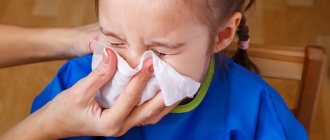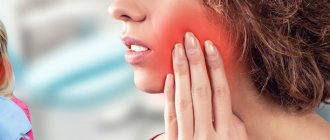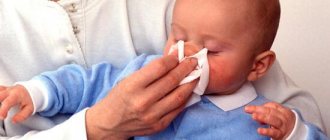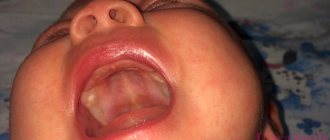When and in what order do baby teeth emerge?
For most children, the teething pattern looks like this:
- At 6-8 months, two central lower incisors appear.
- At 8-9 months, the upper central incisors.
- At 9-12 months, the upper lateral incisors erupt.
- At 11-12 months, the lower lateral incisors.
- At 12-15 months, the upper and lower molars.
- At 16-18 months, the upper canines
- At 18-20 months, the lower canines.
- Chewing teeth erupt at 2-3 years of age.
During normal development, baby teeth erupt in each area within 2-10 days, and the most unpleasant symptoms usually appear within 2-5 days. All 20 baby teeth erupt by age 3.
What to do if teeth are cut chaotically and behind schedule?
There is no need to sound the alarm right away. In some children, teething begins at 3 months, and in some at 10, and this is not a pathology, but a feature of the body. The same applies to the violation of the order of appearance of the incisors.
But if there is a delay of 3-5 months, you need to go for a consultation with a pediatrician or dentist.
Ways to relieve teething pain
How can you help your baby cope with teething?
Teething is a difficult time for both children and parents. Most often, children become excitable, capricious, and irritable. Additionally, there are other signs of teething such as increased drooling or drooling. There is no need to worry too much as there are several ways that can help reduce discomfort and pain.
What is teething?
When teething occurs in babies and children, the growing teeth begin to penetrate the gum tissue that hides them and come out. Some children experience more severe pain, others less. Here are some signs and symptoms that can tell you your baby is starting to teethe:
- The gums in the area where the tooth is expected to erupt become inflamed and swollen.
- Your baby's cheek on the teething side may become red and hot.
- Children may constantly rub the ear on the teething side.
- The child begins to chew everything that comes to hand.
- Salivation increases, which can result in irritation on the chin.
- The child becomes irritable and shows other signs of discomfort, such as restless sleep and refusal to eat.
- During this time, children's temperature may periodically rise slightly.
What is the average duration of teething in children?
Typically, the first tooth appears between 6 months and one year of age.
A baby is born with all 20 baby teeth already under the gum - just waiting to emerge. And there is a clear pattern or order of teething. The front teeth (incisors) usually erupt first, and all subsequent teeth, upper and lower, appear one after another. The first molars at the end of the gums begin to appear around 12–15 months of age, while the canines usually erupt by the age of one and a half years. All baby teeth usually appear by age three.
How to soothe teething pain:
There are several options for helping your baby teething to make this difficult period of his life more comfortable:
Chew toys
You can purchase special chewing rings in a wide variety of shapes and materials designed for a child during this period. These rings help to significantly reduce the child’s discomfort and help the tooth appear as quickly as possible.
You can also use chewing toys (made from special soft fabric) and various nipples for a baby bottle.
Proper nutrition
Cool water is the best option during teething, especially if your baby drinks from a special sippy cup. Drinking a chilled drink will somewhat soothe irritated and inflamed gums in the same way as drinking fruit purees or drinking yoghurt in a cool form.
Creative distraction or special game
Try to distract your child with some creative activities from discomfort and pain in the mouth. Cuddle him, play with him, prepare a warm bath for him. If your baby is still breastfed, feed him.
Gum massage
If you lightly massage your baby's gums with a clean finger, the pain will calm down a little. This may also help the tooth erupt.
Skin protection
You can use baby cream to reduce chin irritation. It is also necessary to change the child’s bedding in a timely manner.
Dental gels
Such drugs are presented by many pharmaceutical companies. They may contain local anesthetic components. Gels give temporary results because they are easily washed off with saliva.
Children's dental gels contain components with a high safety profile, some of which can be used as early as 5 months of age. It is recommended to follow the instructions for use and use only drugs that are registered for children of the appropriate age.
Fever and pain
You should see a doctor if your baby has a high fever or is unusually uncomfortable or painful, which indicates something more serious than teething symptoms.
Finally, don't forget that all children teeth naturally, so don't take your child's painful illnesses too seriously during this difficult time for him (and his family).
What are the common teething symptoms and what do you recommend?
- Profuse salivation.
One of the most obvious signs is when drool is literally flowing in a stream. Moreover, the symptom may appear a couple of months before the start of eruption.
Saliva should be carefully wiped away as it appears damp towel or napkin so as not to damage the skin. It is best to use wipes that contain xylitol - it prevents the growth of bacteria and the appearance of rashes on the skin.
- A strong desire to put everything in the mouth and chew.
Chewing helps your baby relieve the itching. The main thing is to hide objects that he could accidentally swallow or injure himself.
Lifehack. Bend your index finger and gently insert it into your baby's mouth. If he starts squeezing it with his gums, it means teeth are definitely coming out. If it just sucks, then it’s something else.
- Skin rashes.
A small rash on the cheeks or chin may occur due to skin contact with saliva. On irritated skin you just need to apply baby moisturizer.
ATTENTION! If the rash around the mouth appears without other symptoms of teething, it is better to show the child to the pediatrician!
- The baby cannot suckle normally.
At the peak of feeding, he abandons her and begins to act up. And sometimes he can bite with his gums. In such a situation, there is no need to force the child to eat. Even if he misses 2-3 feedings, nothing bad will happen. When he gets really hungry, he will still take the breast or bottle and eat. If you have no appetite for more than 24 hours, call a doctor.
- Redness and swelling of the gums.
It begins 2-5 days before teeth appear, goes away on its own, you don’t need to do anything.
You can also notice a blue bubble on the gum. This is a eruption hematoma. It occurs as a result of the destruction of small vessels in the gums during tooth eruption. It does not require any specific treatment. It will soon resolve on its own.
The best gels with an analgesic effect
Analgesics that are used during teething can be divided into 2 main groups. The former contain lidocaine, benzocaine or similar local anesthetics. Others are dominated by natural ingredients.
Kamistad Baby gel
Rating: 4.9
The first nominee in our review was the German gel Kamistad Baby. It contains 2 active components: chamomile flower extract (soothes, relieves inflammation, heals mucous membranes) and polidocanol (cools and distracts the gums during teething). This remedy is suitable for small children (from 3 months), when they experience the first signs of the appearance of baby teeth.
Gel Kamistad Baby is transparent with a yellow-brown tint. Its taste is pleasant - mint-honey. It is placed in an aluminum tube with a narrow thin dispenser neck. When squeezed out, the gel does not spread because it is quite thick. The product is squeezed onto a clean finger or a cotton swab and distributed over the surface of the gums, lightly rubbing. The manipulation can be repeated 2-3 times a day. It is better to do this after feeding or before bed.
According to reviews from parents, Kamistad Baby begins to act quite quickly. Many adults have experienced it themselves, so they note that the gums seem to freeze after applying the gel. And this effect lasts 20-40 minutes. Usually, after applying this product, babies sleep peacefully for 1-1.5 hours, and then begin to act up again. Parents also note that this gel is quite sticky and they do not feel comfortable using it.
Advantages
- lack of lidocaine;
- convenient tube with a dispensing spout;
- pleasant aroma;
- quickly relieves pain.
Flaws
- short term effect.
Kalgel
Rating: 4.8
Polish dental gel Kalgel contains 2 active ingredients: lidocaine (causes local anesthesia) and cetylpyridinium chloride (has an antiseptic effect). With these remedies it is possible to reduce pain and relieve the inflammatory process on the gums during teething. This medicine is suitable for use if the child is already 3 months old.
Kalgel is a homogeneous, soft gel. There are no grains or inclusions in it. Its color is yellow-brown, close to amber. Kalgel's aroma is quite specific. It is packaged in aluminum tubes in quantities of 10 g. It is enough to take a small pea of the product with a clean finger and carefully distribute it over the painful area, lightly massaging the gums. After 20 minutes, Kalgel can be reapplied. You can do such manipulations a maximum of 6 times per day.
The effect of this remedy develops immediately. The lidocaine contained in the product freezes the gums and all negative symptoms temporarily alleviate the child’s condition. However, this pain relief effect does not last very long and after 40-60 minutes the baby begins to experience pain again. It should also be borne in mind that lidocaine is a potentially dangerous substance for children and can cause a number of negative consequences.
Advantages
- quickly relieves pain;
- pleasant organoleptic properties;
- Allowed for children from 3 months.
Flaws
- relieves pain for a short time.
Dentinale Natura gel
Rating: 4.7
Italian gel Dentinail Nature contains 3 natural active ingredients: aloe vera juice, boswellia and chamomile extracts. With Dentinale natura, the gums become less sensitive during teething, and their irritation and inflammation decrease. With this remedy, the period of appearance of baby teeth will be more comfortable and the use of synthetic anesthetics and analgesics will be avoided.
Dentinyl Natura is in an aluminum tube (20 ml). This gel is transparent with a yellowish tint. It has a pleasant, menthol taste. You can apply the medicine using a washed finger. During manipulation, everything should be done very delicately. You can repeat the procedure of applying Dentinyl up to 5 times a day. After this, you should not feed the child or give him anything to drink for half an hour.
From the reviews it follows that Dentinale natura begins to act 5-10 minutes after application. With this remedy, the child quickly falls asleep and can sleep peacefully for more than 2 hours. This drug is used quite economically and with it you can “grow” even a single tooth. This product is safe even if a child swallows it. But in some especially sensitive babies, it can still provoke allergic reactions.
Advantages
- natural components of the composition;
- absence of lidocaine, parabens, sugar;
- pleasant taste characteristics;
- relieves pain quite quickly.
Flaws
- May cause allergies in some.
Baby Doctor gel first teeth
Rating: 4.6
Israeli gel Baby Doctor first teeth contains 5 medicinal plants. Together, these herbal components make it possible to relieve inflammation on the gums, relieve severe pain, and heal the mucous membrane that is damaged during the eruption of baby teeth. This medicine can be used by patients who are already 3 months old.
Gel Baby Doctor is completely transparent and quite thick. It comes in a soft plastic tube. Its taste is slightly sour, herbal, with hints of mint. The gel is recommended to be applied to the child’s gums when the first signs of trouble appear during teething. This is done with a well-washed finger. The manufacturer states that this product is safe if swallowed by children.
Usually the effect of Baby Doctor develops almost immediately and lasts for 3 hours. At this time, the child stops putting fingers and toys into his mouth. This drug clearly eliminates itching on the gums for a while. However, there is no lidocaine in the composition, so this remedy does not have pronounced pain relief. In addition, some parents are confused by the presence of methylparaben in the composition.
Advantages
- the composition is rich in natural ingredients;
- does not contain lidocaine;
- pleasant to use;
- perfectly eliminates itching on the gums.
Flaws
- contains methylparaben.
Dentinox
Rating: 4.5
Another worthy nominee in our review was the German Dentinox gel. It contains 3 active components: chamomile (excellently relieves inflammation), lidocaine (causes local anesthesia), lauromacrogol 600 (enhances the therapeutic effect of lidocaine). It is actively used in pediatrics during teething, during which the gums become inflamed, irritated and very painful.
Dentinox gel is homogeneous, slightly cloudy. Its color is greenish-yellow. The aroma smells of chamomile and menthol. It is packaged in metal tubes in quantities of 10 g. The product can be applied with a clean finger or a cotton swab. It is enough to take a small pea of the product and delicately apply it to the painful area, rubbing lightly. The procedure can be repeated up to 3 times a day. It is correct to do this after feeding and before bedtime.
Despite the presence of lidocaine in the composition, which not all parents favor, there are many positive reviews about Dentinox. The product begins to act 2-3 minutes after it is distributed over the area where teething occurs. Its analgesic effect is enough for the child to fall asleep peacefully. Usually the drug is well tolerated, but in some babies it can provoke allergies.
Advantages
- effectively eliminates pain;
- has an antiseptic effect;
- pleasant to use;
- the action develops 2-3 minutes after application.
Flaws
- may cause an allergic rash.
Holisal
Rating: 4.5
Polish gel Cholisal contains 2 active ingredients: choline salicylate (locally eliminates pain, inflammation, hyperthermia), cetalkonium chloride (has an antiseptic effect). The adhesive base of the product contains ethyl alcohol, so the effect when applying Cholisal develops quickly, and the active ingredients themselves remain on the mucous membrane longer. This product is approved for children over 1 year of age.
You can buy 10 or 15 g of Cholisal. It is placed in metal tubes. The gel is homogeneous, transparent, colorless. The aroma is anise, pronounced. When teething, a strip of the product (about 0.5 cm) is squeezed onto a clean finger and gently rubbed into the painful area, gently massaging the gums. It is allowed to use Cholisal 2-3 times a day.
The child usually calms down 3-5 minutes after applying the product to the area where teething occurs. The pain relief effect lasts differently for everyone, but it usually lasts 2-8 hours. However, adults note that most often there is a short-term mild burning sensation at the sites where the drug is applied. Many people like that this product does not contain lidocaine and sugar.
Advantages
- good combination of active ingredients;
- lack of sugar and lidocaine in the composition;
- comfortable gel to use;
- quickly relieves pain.
Flaws
- A slight burning sensation is felt immediately after application.
Pansoral first teeth
Rating: 4.5
French oral gel Pansoral first teeth contains liquid extracts of chamomile, marshmallow, saffron, and Irish moss among its active ingredients. Has anti-inflammatory, analgesic, antimicrobial effects. This product does not contain lidocaine and is suitable for babies from 4 months.
Pansoral first teeth is sold in soft tubes of 15 ml. It is a transparent gel with a yellowish tint. The product has no smell. The consistency is moderately liquid. The product is easily squeezed out of the tube and is well distributed over the gums. Apply the medicine with a clean finger and lightly massage the painful area. The manipulation is repeated as necessary.
Parents report that in the beginning it is quite difficult to get used to applying this product correctly. But when this begins to work out, the analgesic effect becomes more pronounced. From the reviews it follows that Pansoral is consumed very economically. But some parents are confused that this product contains parabens, and also that there are no instructions in Russian.
Advantages
- contains many medicinal plants;
- pleasant gel consistency;
- when applied correctly, it provides excellent pain relief;
- economically used.
Flaws
- contains parabens;
- no instructions in Russian.
What are the complications, and when to see a doctor?
| Symptom | Teeth are being cut, there is no need to go to the pediatrician | The disease develops, contact your pediatrician |
| Cough | A coughing attack begins due to excess salivation. The cough is wet and infrequent. | The cough gets worse, does not go away, does not allow the baby to sleep, and prevents him from eating. Doesn't stop for more than 2 days. Breathe heavily. |
| Nasal discharge | Nasal discharge is transparent and watery and disappears by the 4th day. | The runny nose does not go away for the 4th day. Lots of yellow or green discharge. |
| Heat | The temperature does not exceed 38 °C and lasts no more than 2-3 days. Rapidly decreases under the influence of antipyretics. | Fever above 38.5 °C for more than 2 days. Signs of a cold appear (severe cough and runny nose). |
| Loose stools | Lasts less than 72 hours. | Lasts more than 72 hours. |
| Changes in the oral cavity | The gums become swollen and red. | The oral mucosa is covered with white plaque or ulcers. |
Symptoms of the onset of baby teeth
First of all, parents need to be able to recognize when the teething process has begun. The appearance of the first teeth has the following symptoms:
- inflammation and redness of the gums;
- increased salivation;
- change in the child’s appetite (the baby may refuse food altogether or, conversely, try to eat inedible);
- biting and attempts to gnaw everything on the part of the child (due to the fact that the gums itch during teething);
- not a significant increase in body temperature for a period of 1-2 days (due to the fact that an increased amount of biologically active substances is released in the body);
- slight (up to 3 days, with a frequency of up to 3 times a day) diarrhea, due to the fact that salivation increases and a lot of saliva enters the child’s gastrointestinal tract;
- mild runny nose (clear nasal discharge for about 4 days);
- wet cough (also due to increased salivation);
- lack of sleep (due to discomfort).
What problems can arise during teething?
- Teeth cutting too late. A period of more than 2 months from the moment when they should have started to erupt is considered late.
- Teeth are cutting too early. Although there are cases when a child is born with teeth already erupted. But still, if teeth begin to appear for the most part too early, this is a cause for concern.
- The appearance of teeth outside the dentition.
- Incorrect formation of newly erupted teeth.
- Violation of the order of eruption of the incisors or the absence of one of the teeth.
If symptoms (fever or runny nose) last longer than a couple of days, the child should be seen by a doctor immediately!
What can be done to help a child with severe itching and pain?
- Carry your baby in your arms more often, play with him and distract him.
- Give chilled water in a bottle, cool fruit puree or kefir. The main thing is that the liquid is not too cold, otherwise the baby will catch a cold.
- Massage the gums with a special silicone brush (see picture above) or you can gently use your clean finger.
- Buy your baby a teether and let's chew.
Such devices are made from plastic, rubber, silicone, wood, or a combination of different materials. The surface of the toys should be elastic and uneven to make it easier for the child to scratch the gums. A cooled teether relieves itching better, so it can be placed in the refrigerator to cool for 10-15 minutes. But don't chill it in the freezer!
- Do not use gum gels with lidocaine and benzocaine.
The child has a lot of saliva in the mouth, so gels are not effective during this period. The child swallows most of the gel.
Traditional methods
The natural period in the life of a little person is made easier with the help of folk recipes.
Warm herbal tea
Discomfort in the gums and itching are relieved by decoctions of medicinal herbs. Chamomile, lemon balm, lavender, mint are suitable for the recipe. Pour 1 tablespoon of dry plant into a glass of boiling water and leave for 20-30 minutes. The prepared drink is given instead of water; it is useful for breastfeeding mothers to drink.
Clove oil
Clove oil quickly relieves the condition, which before use is diluted with any base vegetable oil in a 1:1 ratio. The product is rubbed into the painful area.
Soda solution
Swollen areas are wiped with a piece of bandage or cloth soaked in a baking soda solution. It is important to perform the procedure with sterile hands.
Sage decoction
A herbal decoction of sage is rubbed into the hard area. The folk remedy will not only soothe swollen tissues, but also strengthen the enamel. The decoction is also added to the baby's bath during bathing.
Mumiyo
Shilajit, a natural product with a powerful healing effect, has been used for a long time.
Natural honey
If you are not allergic to honey, then wipe your gums with a piece of the solid product. The procedure is carried out with light rubbing movements.
Valerian
A compress made from valerian extract helps relieve anxiety and pathological symptoms.
Solid food
Solid foods help distract from the problem. You can give a cold apple or carrot to chew on, but you need to be careful so that a large piece of the vegetable or fruit does not break off. A piece of dry bread, or its crust, or cookies will do.
Don't forget about the local effects of cold. Both special silicone and plastic products with liquid inside, as well as cooled silicone objects and toys are suitable for this.
Recommendations! If a child is teething, the doctor will always tell you how to numb the pain. If there are contraindications to drug treatment, folk remedies will always come to the rescue.
Solid Vegetables for Baby Gums
What should you not do when your baby is teething?
- Strongly touch the child’s gums with your fingers, press on them and pick them out. This can increase pain or cause infection.
- Conduct vaccination, because immune system is weakened during this period .
- Without supervision, allow your child to chew any hard foods that could cause choking.
- Give homeopathic remedies. Not only will they not help the child, but they can cause serious harm.
The eruption of baby teeth is not a problem, but a natural process for a child’s body. But if you are not sure about something, do not hesitate to ask specialists. If you have any questions, write to us on Instagram.
How wisdom teeth erupt
This process occurs starting from the age of 16 or at a later age. Dentists do not consider the eruption of these teeth to be a deviation even after 40 years.
Over the years, the jaws decrease in size, and there is no room left for the “eights”. If eruption is delayed, an x-ray should be taken to see the reason.
The path of this tooth passes through fairly thick soft tissue, so the following symptoms appear:
- Pain in the problem area or radiating to the jaw;
- Redness;
- Edema;
- Difficulty eating and opening the mouth.
Other manifestations are also possible:
- Second molars suffer from root or cervical caries;
- If the swelling is extensive, the throat and gums may hurt, causing odontogenic sore throat.
Medicines
Using analgesics will eliminate the pain, but its source will remain. Use:
- Anti-inflammatory drugs to reduce fever and swelling (paracetamol, ketorolac, ibuprofen);
- Analgin and local anesthetics reduce tissue sensitivity;
- Antiseptics (miramistin, chlorhexidine) - act on pathogenic microorganisms.
How to get rid of the problem
When wisdom teeth erupt, many try to solve the problem on their own - with the help of medications or traditional methods. Rinsing and pain relief on your own are acceptable measures, but only after visiting the dentist’s office and receiving medical advice.
The following options can be used:
- medications to relieve pain and inflammation;
- surgical solution;
- use of traditional medicine.
It is often most effective to use all options.
